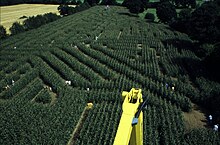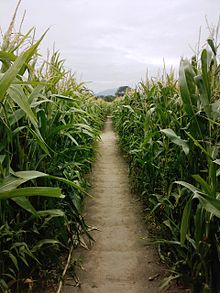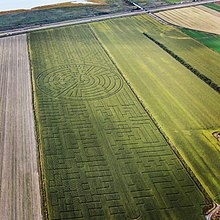Corn maze


A corn maze or maize maze is a maze cut out of a corn field. Corn mazes have become popular agritourism attractions in North America, and are a way for farms to generate tourist income. Corn mazes appear in many different designs. Most have a path which goes all around the whole pattern, either to end in the middle or to come back out again, with various false trails diverging from the main path. In the United Kingdom, they are known as maize mazes, and are especially popular with farms in the east of England.
These mazes are normally combined with other farm attractions of interest to families and day trippers. Some of these attractions include hay rides, a petting zoo, play areas for children, and picnic areas. Each year a few of the mazes are featured in national newspapers and TV.
In the U.S., corn mazes typically are cut down circa the first week of November; in the UK typically in September after children return to school.[citation needed]

Size[edit]
Mazes may cover 2–9 acres (0.81–3.64 hectares).[2] Larger mazes can have more design details.[2]
As of January 2023[update], the Guinness World Record for largest temporary corn or crop maze was 65.8 acres (266,000 m2), created by Luc Pelletier in La Pocatière, Québec, Canada, in October 2022.[3]
In 2012, a maze in Lacombe, Alberta, Canada earned the Guinness World Record for the largest scannable QR code on Earth.[2] It was about 29,000 square metres (7.2 acres).[4]
Designs[edit]
Designs may be simple lines, or they may produce an overall image that can be seen from above. Many are based on artistic designs such as characters from movies. Some mazes are even created to tell stories or to portray a particular theme. Complex designs include those featuring popular singers,[2] movies,[5] farming themes,[6] patriotic themes,[2] or historical events.[7]
Complex designs may be produced by a specialty company.[2][8]
A large maze may be broken into several sections.[6][2] This allows people to chose a path with the length and complexity that they want.[2][6] For example, a family with small children may want to choose a shorter, simpler portion, and others may want to do multiple sections.[2][6] An unusually large corn maze at Stoney Brook Farms in the US, which covers an area of 110 acres (45 ha), has a total of 15 miles (24 km) of pathways.[8]
The designs may be cut earlier in the season, when the corn plants are shorter (about 12 inches (30 cm) tall), or during the summer, when they are taller.[2][9] In other cases, the corn is planted to form the maze, using GPS mapping technology.[8]
Revenue[edit]
Corn mazes are usually created because they can bring money into a family farm.[6] Some farms also donate a portion of the proceeds to a charity.[5][9]
History[edit]
The first full-size corn maze is believed to have been created in Annville, Pennsylvania in 1993,[10][unreliable source?] although the Los Angeles Times mentioned the existence of a corn maze at the R&H Ranch, in Lancaster, California, in 1989.[11]
Creation[edit]
This section needs additional citations for verification. (October 2023) |
In order for farmers to create a corn maze they must carefully plan their production, design, and marketing techniques in advance.
- Planting the correct variety of corn is important for the success of a corn maze. Farmers must consider stalk strength and height when selecting the right hybrid to plant.
- Farmers must watch for stalk rot since it is one of the most frequently observed diseases. Key factors for stalk rot include improper fertilization, moisture stress, and disease development.
- Moderate plant population (about 20,000 plants per acre) would be considered ideal. If moderate plant population is not followed crop crowding can occur.
- Since farmers planting for corn mazes are not growing the crop for maximum yield they should not apply too much nitrogen fertilizer. Rutgers Cooperative Research and Extension recommends the total nitrogen rate for the season should not exceed about 125 pounds per acre[12] (140 kg per hectare).
- Corn maze crops should be planted from mid to late May in the northern hemisphere, or mid to late November in the southern hemisphere. This is two to three weeks later than crops being planted for grain.
- When cutting the walkways farmers must cut the internal growing point of the stalk off to avoid regrowth. Some farmers use herbicides, roto-tillers, or mowers to cut the walkways.[citation needed]
See also[edit]
References[edit]
- ^ "Largest corn / crop maze (temporary)".
- ^ a b c d e f g h i j Lowder, J. Bryan (2023-10-28). "The A-maize-ing Life of a Corn Maze Designer". Slate. ISSN 1091-2339. Retrieved 2023-11-07.
- ^ "Largest corn / crop maze (temporary)". Guinness World Records. 18 October 2022. Retrieved 2023-01-24.
- ^ "Alberta family's QR code named world's largest by Guinness". The Canadian Press. 9 September 2012.
- ^ a b Altman, Jim (13 October 2023). "The Lyman Orchards Corn Maze offers a direct path to help their charity". WTIC-TV Fox 61. Retrieved 2023-11-07.
- ^ a b c d e Morrison, Andy (15 October 2023). "Michigan Marvels: Gigantic corn maze a place to get lost, laugh about it". The Detroit News. Retrieved 2023-11-07.
- ^ Loewenson, Irene (2023-10-06). "Farmers grow corn maze marking 40 years since tragic attack on Marines". Marine Corps Times. Retrieved 2023-11-07.
- ^ a b c Lauritsen, John (22 October 2023). "A look at how a massive corn maze is built". CBS Minnesota.
- ^ a b "Kelder's Farm shows New York a bit of corn maze love". AGDAILY. 2023-08-18. Retrieved 2023-11-07.
- ^ "Nation's First Corn Maze Rooted at LVC". Lebanon Valley College. October 29, 2010. Archived from the original on 2015-05-26.
- ^ Milstead, Janey (October 15, 1989). "Pumpkin patches". Proquest Historical Newspapers: Los Angeles Times. Retrieved October 22, 2023.
- ^ Heckman, J., & Sciarappa, W. (2004, June). Rutgers NJAES Cooperative Extension: Growing an "A-maize-ing" Corn Maze Archived 2013-10-04 at the Wayback Machine (PDF). Retrieved July 25, 2008
External links[edit]
- Maize Maze Association – Trade Association for UK Maize Maze owners and operators, lists UK Maize Mazes.
- The Cornies – Twelve Czech maize mazes ("Kukuřičáci").
